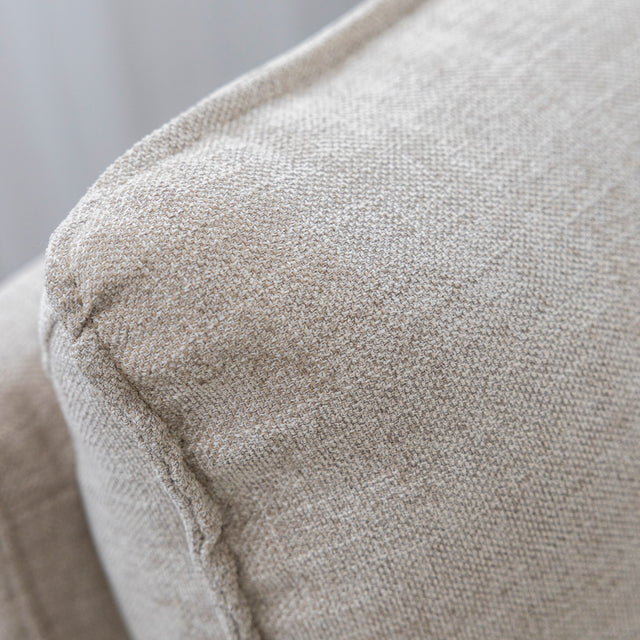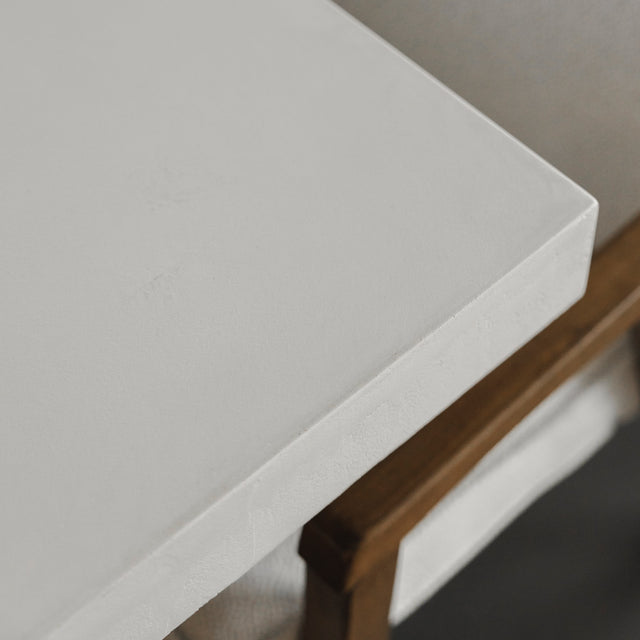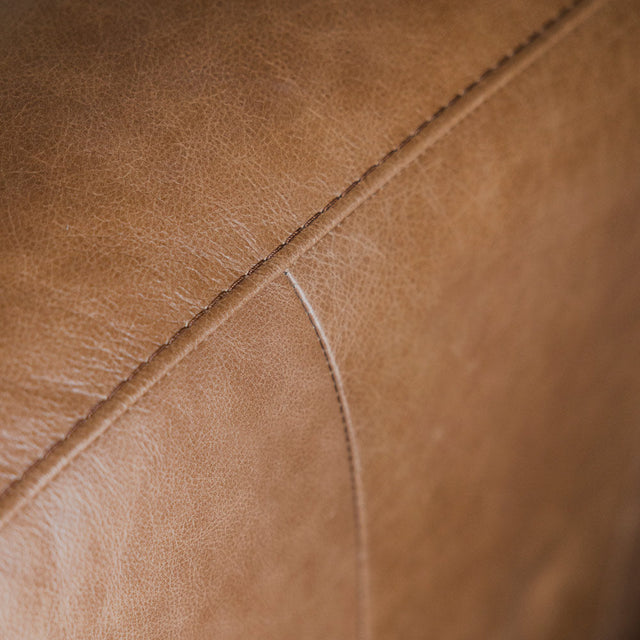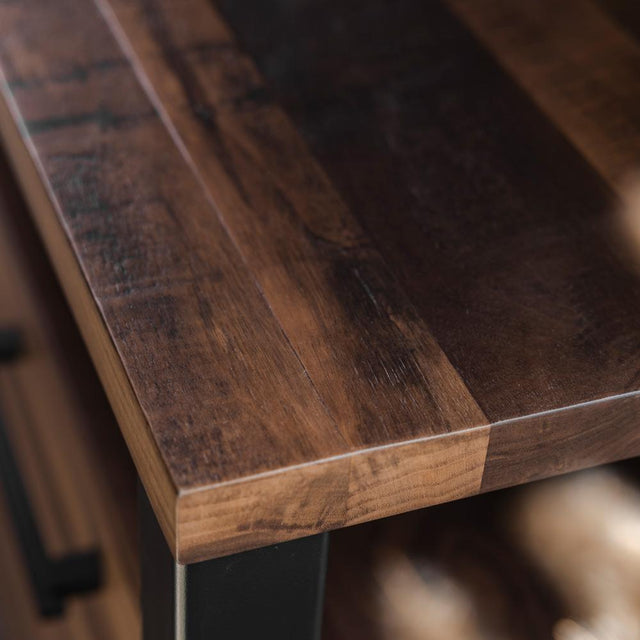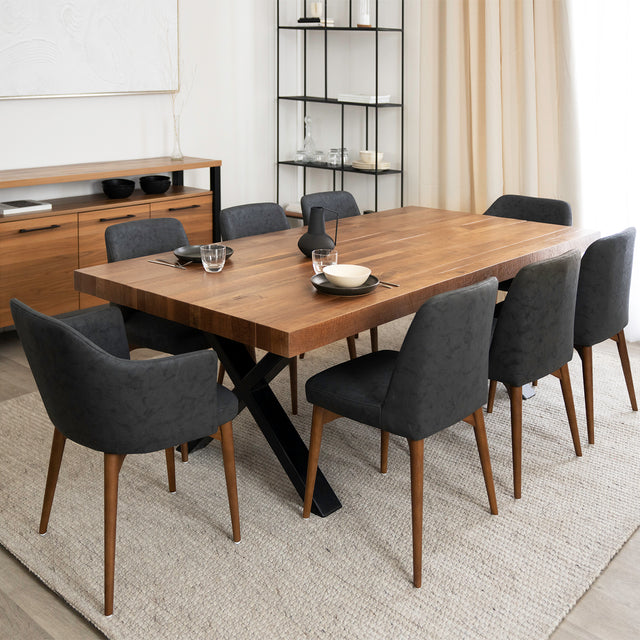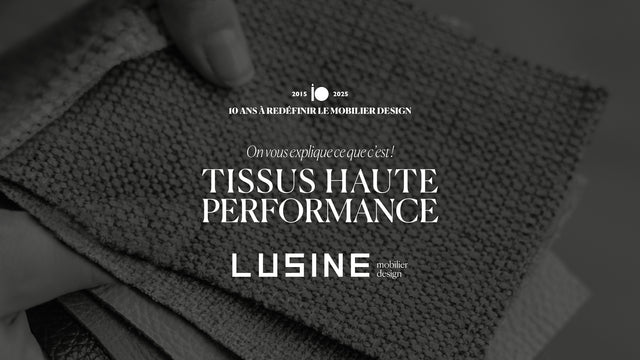Learn all about natural variations, maintenance and use of our materials
FURNITURE CARE GUIDE
Taking care of your furniture is essential to prolong its durability and aesthetic appearance. Whether wood, leather, fabric or concrete, each material requires special attention to stay in good condition. This guide will provide you with practical advice on how to effectively care for your furniture, to ensure that it remains beautiful and functional for many years to come.
Furniture care guide
Variations
This material may contain small irregularities which occur naturally and which are an integral part of the characteristics of our steel products.
Use & maintenance
To clean steel, it is recommended to use only a mild soap, such as dish soap. Any corrosive or chemical product is likely to permanently damage the finish.
Even though our finish is water resistant, it is important to wipe up a liquid spill as quickly as possible.
Protection against direct heat sources is required to avoid damage to your property.
The furniture is not intended for outdoor use.
Despite the hardness of the product, an impact on the furniture could cause breakage.
Aging
No matter the material, natural light affects color over time.
Even with finishing, impurities could lodge in imperfections in the steel over time.
Variations
Since concrete is a hand-applied material using a unique curing process, it may have irregular markings and variations in its shades and texture.
Use & maintenance
To clean concrete, it is recommended to use only a mild soap, such as dish soap. Any corrosive or chemical product can permanently damage the finish of the concrete.
Even though our finish is water resistant, it is important to wipe up a liquid spill as quickly as possible.
Protection against direct heat sources is required to avoid damage to your property.
Our furniture is not designed for outdoor use.
Despite the hardness of the product, an impact on the furniture could cause breakage.
Aging
No matter the material, natural light affects color over time.
Heat and humidity are also factors that can affect the stability of concrete. This could be visible, among other things, through seasonal changes.
Even with the finish, impurities could lodge in the porosities of the concrete over time.
Variations
As wood is a natural material, it is normal to notice variations in grain, color or even the presence of knots. Each piece of furniture is unique: the width of the boards and, if applicable, the texture of the wood may vary.
Use & maintenance
To clean wood, it is recommended to use only a mild soap, such as dish soap. Any corrosive or chemical product can permanently damage the wood finish.
Even though our finish is water resistant, it is important to wipe up a liquid spill as soon as possible.
Protection against direct heat sources is required to avoid damage to your property.
Our furniture is not designed for outdoor use.
Despite the hardness of the product, an impact on the furniture could cause breakage.
Aging
No matter the material, natural light affects color over time.
Heat and humidity are also factors that can affect the stability of wood. This could be visible, among other things, with the changing seasons.
Even with the finish, impurities could become lodged in the pores of the wood over time.
Variations
Because leather is a natural material, it may not have a perfect, regular, or completely uniform appearance. It may have specific characteristics such as scars, stains, or color variations. The grain and shade may vary; it is a hide.
Use & Maintenance
Leather care is necessary to maintain its appearance and durability.
MOISTURIZE THE LEATHER
The required moisturizing frequency depends on sun exposure. Extensive exposure dries out the leather, making it more likely to mark, crack, and/or develop irreversible damage. Depending on their sun exposure, different parts of the same piece of furniture may have different leather moisturizing needs.
To determine if leather needs to be moisturized, apply cream* to the leather. If the leather absorbs the product, it means it needs to be moisturized. If the product is not absorbed by the leather, it means the skin is sufficiently moisturized. To remove excess product, wipe with a dry cloth. This will prevent grease stains on clothing.
*Ask an advisor about or purchase the leather hydration product.
LIQUID DAMAGE
Avoid exposing leather to water and liquids. If liquid spills, gently blot it up. Leather generally allows sufficient time for cleaning before the liquid is absorbed. However, some liquids may stain leather.
Aging
Regardless of the material, natural light affects color over time. Heat and humidity are also factors that can affect leather.
The density of upholstered products varies from one product to another due to their assembly differences. After receiving your upholstered furniture, during the first few months of use, it is normal to lose up to 40% of the density in the padding. The seams will loosen and the shape will soften over time. When possible, we recommend rotating the modules to ensure even wear.
Variations
As marble is a natural stone, it is completely normal to observe variations in color, veining and texture from one piece to another.
Each slab is unique, with its own nuances and slight irregularities that reflect its mineral origin. These natural characteristics are an integral part of the marble's charm and contribute to the authenticity of each piece.
More or less pronounced marbling, subtle contrasts or more crystallized areas can appear, making each surface truly unique.
Use and Maintenance
Marble is a porous natural stone that must be maintained with care.
Sealant
The tables are pre-sealed at the factory with a professional-grade water-based sealer designed for natural stone.
Sealant Maintenance
We recommend re-sealing every 6 to 12 months, depending on usage. A limestone or marble sealer is recommended.
Daily cleaning
Use a soft, slightly damp cloth and mild soap or pH-neutral cleaner (acid- and ammonia-free).
Avoid : Acidic products (vinegar, lemon), abrasives or strong detergents can damage the surface and remove the sealant.
Protection
Always use coasters and trivets to avoid stains or heat marks.
Aging
Surface alteration
Over the years, marble may develop a patina, micro-cracks, or a slight roughness. This is due to erosion, temperature variations, and ambient humidity.
Erosion and softening of edges
Edges and surfaces may gradually soften, especially in high traffic areas.
Appearance of microcracks
Over time, fine natural cracks may appear, without compromising the solidity of the stone.
Stains and marks
Due to its porosity, marble can absorb liquids and stain, especially if it is not sealed regularly.
Loss of shine
Prolonged exposure to light, household products or air may dull its polished finish.
Use & Maintenance
Due to their different compositions, fabrics cannot be maintained in the same way.
It's recommended to vacuum your furniture from time to time, as the dust that collects there can cause long-term damage to the upholstery. Be sure to choose the right vacuum cleaner brush attachment, as some can damage fabrics.
It is recommended to clean your furniture with water only. Use mild soap for any stubborn stains. Ask your advisor about service plans and stain removal products available in store.
Pilling
The beauty of a fabric comes from its composition or its weave type. These same characteristics will influence its tendency to pill.
The fact that a fabric pills does not make it a poor quality fabric, but rather a fabric that will require special care. Also, pilling does not damage the fabric.
Pilling can occur when fabric comes into contact with other materials such as blankets, clothing, or even excessive vacuuming. Other factors, such as humidity, can affect pilling.
Pilling is likely to occur, especially in the first few months/years, and will eventually stabilize. It is important to treat pilling at the first sign with a suitable razor.
Aging
Regardless of the material, natural light affects color over time.
The density of upholstered products varies from one product to another due to their assembly differences. After receiving your upholstered furniture, during the first few months of use, it is normal to lose up to 40% of the density in the padding. The seams will loosen and the shape will soften over time. When possible, we recommend rotating the modules to ensure even wear.
Variations
Since travertine is a natural stone, it is normal to observe variations in color, texture and veining from one piece to another.
Each piece is unique, with its own nuances and irregularities that contribute to its charm and authenticity. The surface may have natural cavities and subtle differences that make each travertine creation incomparable.
Use and Maintenance
Travertine is a porous natural stone that must be carefully maintained.
Sealant
The tables are pre-sealed at the factory with a professional-grade water-based sealer designed for natural stone.
Sealant Maintenance
We recommend resealing every 6 to 12 months, depending on usage. A limestone or marble sealer, such as Miracle Sealants 511 Impregnator or an equivalent product, is ideal.
Daily cleaning
Use a soft, slightly damp cloth and mild soap or pH-neutral cleaner (acid- and ammonia-free).
Avoid : Acidic products (vinegar, lemon), abrasives or strong detergents can damage the surface and remove the sealant.
Protection
Always use coasters and trivets to avoid stains or heat marks.
Aging
Alteration of color
Travertine may darken slightly or patinate from the elements and daily use.
Erosion and softening of edges
Edges and surfaces may gradually soften, especially in high traffic areas.
Appearance of microcracks
Over time, fine natural cracks may appear, without compromising the solidity of the stone.
Cavity transformation
Travertine is naturally porous; some cavities may enlarge or gradually fill with dust or minerals.
Modified shine
If travertine was polished, its finish may become more matte over the years due to friction and exposure. This natural aging process enhances its character and history, making each surface unique.
High-performance protection and service plans
In addition to good care practices, certain technologies can help you preserve your furniture even more effectively. Our high-performance fabrics create an invisible barrier against liquid-related stains, while our service plan offers extended coverage for lasting peace of mind. Available only at the time of purchase, this plan ensures professional support should you need it.
To find the option best suited to your furniture, consult one of our design consultants.
High performance fabrics and service plan
This treatment forms an invisible and durable protective layer, acting as a barrier against liquid-related stains, thus providing better protection than untreated fabric.
The coating of this product creates an invisible and durable protective barrier that protects better against stains caused by liquid than an untreated fabric.
Concretely:
- Liquids bead up and the reaction time is significantly longer to mop up the mess.
- Liquid spills are easier to clean up.
- Antibacterial and antimicrobial protection.
It is a protection that prevents the growth of bacteria and microbes in the fabric fibers. This results in preventing odors and the buildup of fungi in textile products, as well as the spread of bacteria and microbes through the textile.
Not all solutions purchased separately have the same level of effectiveness. These solutions are sprayed, usually unevenly, and only last a few years.
The protector is specifically designed to make liquids bead up to extend the reaction time for soaking up the spill. A stain caused by another source (food) may still be difficult to remove. Additionally, a liquid spill left on the fabric for too long could still remain stained and eventually soak through the protector.
This is a relatively new technology and isn't yet available on all coatings. However, we've had some favorites for other coatings that don't have this treatment, and we wanted to make them available anyway. We always recommend adding our service plan in all cases because it will remove the stain in case of a problem.
The service plan comes with a stain remover product suitable for your upholstery in addition to 10 years of service!
For the first 5 years: A specialist will come to your home to clean the stain. If the stain persists, the furniture will be sent for repair. If a repair is not possible, the furniture will be replaced.
For the past 5 years: A specialist will come to your home to clean the stain. Repair or replacement is no longer available.
FABRICS
All kinds of stains, for example:
- Jeans dyeing
- Wine or other beverage
- Food
- Makeup
- Paint
- Coloring pencils
- Grass and soil
- etc
LEATHER OR VEGAN LEATHER
- Tasks
- Cigarette burns
- Accidental cuts, incisions & punctures*
*Excluding those caused by animals or manufacturing defects
*Options are also available for motorized tables and furniture.*
Important nuances & exclusions:
Cleaning or repairs are limited to the original value of the covered item.
In the event of a replacement, the plan only covers the original item purchased. Once the original item is replaced or if the original item has had an amount equivalent to its value in repair costs, the service plan is considered to have fulfilled its obligations.
In the last 5 years of the plan, there is only one attempt at spot cleaning. This is also the case in the first 5 years, except that if the cleaning does not work, we move on to the repair and/or replacement stage.
Cleaning covers stains, not odors.
Stains caused by corrosive products, such as bleach, are not covered.
Dirt resulting from normal daily use (perspiration, body oils & hair) is not covered.
Damage caused by batteries is not covered.
Cleaning your furniture with products other than those provided may void the service plan.
Spray a small amount (do not soak) of the stain remover onto a clean sponge.
Squeeze the sponge several times to create a lather. Apply the lather with the sponge in small circular motions to the stained area.
Continue with circular motions until the stain is gone. This should take no more than 30 seconds. Do not soak the fabric.
Dab off any excess stain remover remaining on the surface using a clean, soft, white cloth.
Rotate the cloth as you blot to ensure you use a clean, dry surface each time. This will prevent the stain absorbed by the clean cloth from being reapplied to the fabric.
Using a new, clean, white cloth , gently dry the surface. Pay particular attention to the edges of the cleaned surface and the dry surfaces of the fabric. This will integrate the newly cleaned surface with the dry surfaces of the fabric.
Allow to dry completely for 24 hours. Gently brush the fabric to restore its original appearance and texture.
